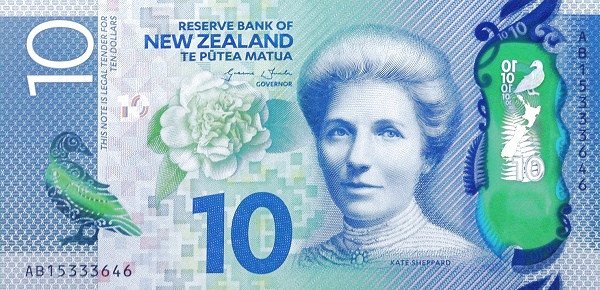NZD/USD Jumps Higher than 0.5750 as China’s Economic Data Increases Market Optimism and Weakening USD
The pair NZD/USD moved higher than the 0.5750 level, picking up strength for a second day in a row after the publication of strong economic data from China. Retail Sales in China increased by 4.0% year-on-year in January-February, and Industrial Production grew by 5.9%, both showing enhanced economic activity and improving market optimism in the Asia-Pacific economy. Since China is still one of New Zealand’s most important trading partners, these encouraging signs supported the Kiwi. Further optimism was provided by China’s recently launched consumption stimulus plan. The US Dollar, on the other hand, lost strength as the University of Michigan’s Consumer Sentiment Index plummeted sharply, further supporting NZD/USD’s bullish trend. KEY LOOKOUTS • Greater-than-anticipated Retail Sales and Industrial Production in China increase NZD sentiment, supporting optimism in Asia-Pacific market dynamics. • A precipitous decline in the Michigan Consumer Sentiment Index presses the US Dollar, providing support to NZD/USD advances. • China’s special action plan to promote consumption, wages, and real estate sentiment favors regional currencies, including NZD over USD. • Weakness in New Zealand’s Performance of Services Index is a domestic signal, and if global sentiment reverses, this could restrict NZD’s rally. The NZD/USD currency pair continues to strengthen with the support of positive Chinese economic data and a soft US Dollar. China’s Retail Sales increased by 4.0% and Industrial Production grew 5.9% in January-February, which indicates good economic momentum and raises investor sentiment in the Asia-Pacific region. The New Zealand Dollar also gained from China’s new stimulus package that was created to boost domestic consumption, pay, as well as stabilize markets. On the other hand, the US Dollar remained on the back foot after a steep fall in the University of Michigan’s Consumer Sentiment Index to its weakest level since November 2022. In spite of a decline in New Zealand’s services sector, the favorable external environment remains in support of NZD/USD’s rise. NZD/USD climbs above 0.5750, led by robust Chinese economic data and a softer US Dollar. The pair’s upside is also supported by China’s new consumption stimulus plan. Even with domestic service sector softness, the pair continues to rally. • NZD/USD climbed above 0.5750, marking the second straight day of gains on improved sentiment. • China’s Retail Sales grew 4.0% YoY in January-February, from 3.7% in December, supporting regional currencies such as the NZD. • Chinese Industrial Production grew 5.9% YoY, better than expected, and indicating economic prowess. • China rolled out a special consumption stimulus plan, comprising wage increases and efforts to enhance household expenditure and stabilize core markets. • PSI in New Zealand fell to 49.1, indicating services sector contraction that may drag on domestic economic prospects. • US Dollar declined strongly, after a fall in the University of Michigan Consumer Sentiment Index to 57.9, the lowest level since November 2022. • The attention now shifts to US Retail Sales data that may drive the next direction for NZD/USD. China’s recent economic statistics have sent a wave of optimism into the market, particularly favoring the New Zealand Dollar. The increase in Retail Sales and Industrial Production between the months of January-February indicates firmer consumer spending and industrial performance, which supports China’s economic growth. Since China is one of New Zealand’s major trading partners, any good news in its economy will prove favorable to the New Zealand Dollar. In addition, China’s declaration of a special action plan to spur domestic consumption—via wage rises, support for household spending, and market stabilization efforts—has also boosted sentiment throughout the region. NZD/USD Daily Price Chart Chart Source: TradingView Concurrently, the US Dollar is under pressure from declining consumer confidence in the United States. The steep drop in the University of Michigan Consumer Sentiment Index reflects increasing worry about the outlook for the US economy, and this is having an impact on investor sentiment. Although New Zealand’s own service sector has reported signs of slowing, overall market sentiment remains biased towards the Kiwi, owing primarily to superior external drivers. With global markets waiting closely for subsequent economic releases, the overall economic climate remains in the driver’s seat in dictating currency fluctuations. TECHNICAL ANALYSIS NZD/USD is displaying the signs of ongoing bullish strength following the break through the 0.5750 resistance level. The pair remains firm around 0.5760, reflecting buyer demand at higher prices. If the pair holds above this range, it may challenge the next resistance zone of 0.5785–0.5800. On the negative side, support is close to 0.5720, and then a stronger support area around 0.5680. A break below these could mean a loss of momentum. On the whole, the current price action indicates a positive sentiment with the pair remaining in a short-term bullish bias. FORECAST NZD/USD may experience further gains in the short term. Positive economic news from China and the stimulus packages to stimulate consumption are expected to continue supporting the New Zealand Dollar. A break above the 0.5760 level may pave the way towards the next resistance levels at 0.5785 and 0.5800. If the bullish momentum continues, the pair may even try to reach the 0.5820 level, particularly if future US economic data continues to be weak. On the other hand, any change in market mood or disappointing economic news from the rest of the world may initiate a pullback in NZD/USD. In case the pair is unable to stay above 0.5750, it might initially be supported around 0.5720. Breaking below this point might initiate a more serious correction towards 0.5680 or even 0.5650. Moreover, if New Zealand’s economic indicators in the domestic market continue to reflect weakness, it may cap the upside and risk a move down.






